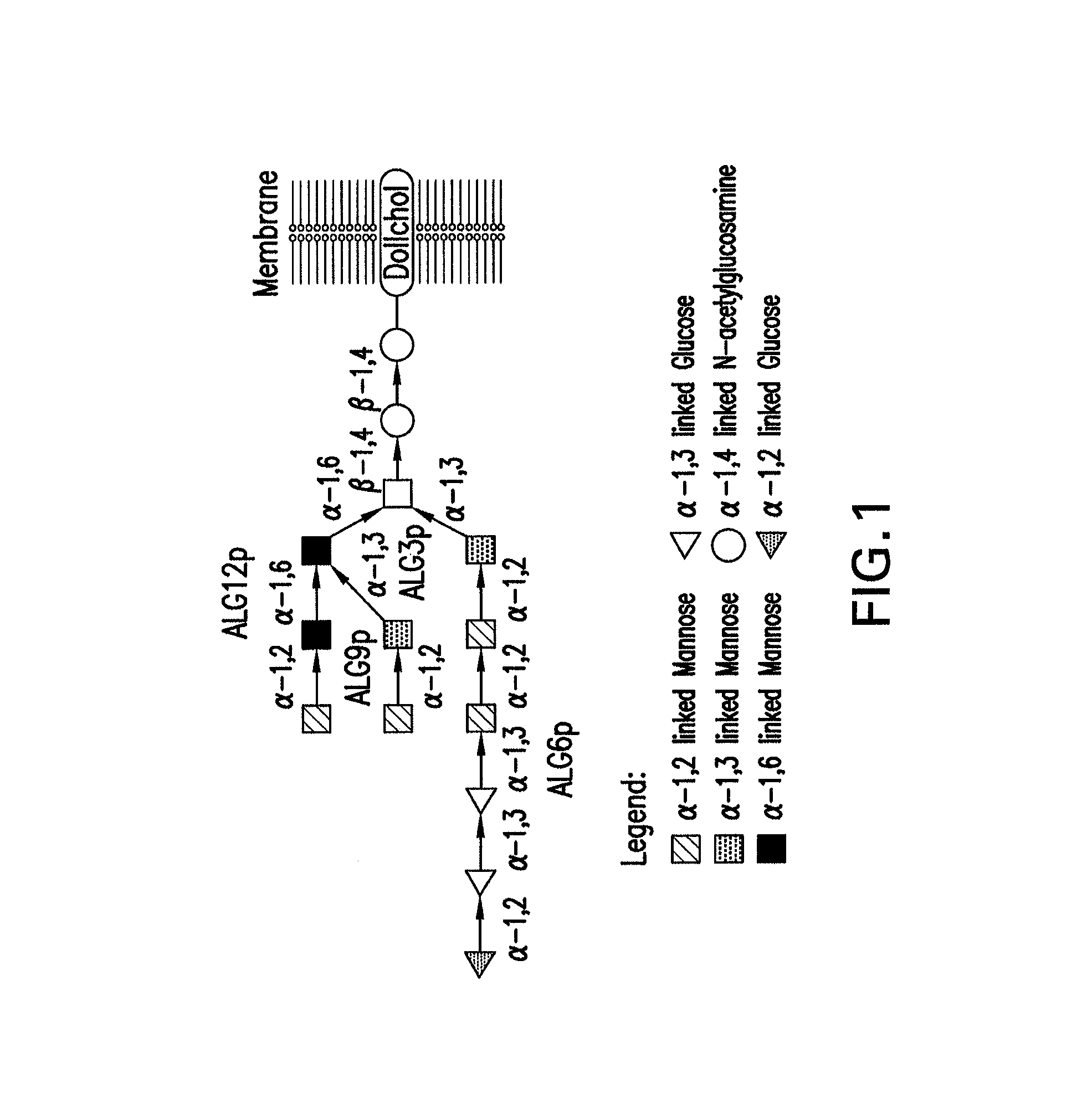Method to engineer mammalian-type carbohydrate structures
a technology of carbohydrate structure and mammalian type, applied in the direction of depsipeptides, plant/algae/fungi/lichens ingredients, fungi, etc., can solve the problems of low product titers, inability to predict reliably, and inability to solve inherent problems of all mammalian expression systems
- Summary
- Abstract
- Description
- Claims
- Application Information
AI Technical Summary
Benefits of technology
Problems solved by technology
Method used
Image
Examples
example 1
Identification, Cloning and Deletion of the ALG3 Gene in P. pastoris and K. lactis
[0261]Degenerate primers were generated based on an alignment of Alg3 protein sequences from S. cerevisiae, H. sapiens, and D. melanogaster and were used to amplify an 83 bp product from P. pastoris genomic DNA: 5′-GGTGTTTTGTTTTCTAGATCTTTGCAYTAYCARTT-3′ (SEQ ID NO. 1) and 5′-AGAATTTGGTGGGTAAGAATTCCA-RCACCAYTCRTG-3′ (SEQ ID NO. 2). The resulting PCR product was cloned into the pCR2.1 vector (Invitrogen, Carlsbad, Calif.) and sequence analysis revealed homology to known ALG3 / RHK1 / NOT56 homologs (Genbank NC.sub.—001134.2, AF309689, NC.sub.—003424.1). Subsequently, 1929 bp upstream and 2738 bp downstream of the initial PCR product were amplified from a P. pastoris genomic DNA library (Boehm, T. Yeast May 1999; 15(7):563-72) using the internal oligonucleotides 5′-CCTAAGCTGGTATGCGTTCTCTTTGCCATATC-3′ (SEQ ID NO. 3) and 5′-GCGGCATAAACAATAATAGATGCTATAAAG-3′ (SEQ ID NO. 4) along with T3 (5′-AATTAACCCTCACTAAAGGG...
example 2
Generation of an alg3 / och1 Mutant Strain Expressing an α-1,2-Mannosidase, GnT1 and GnTII for Production of a Human-Like Glycoprotein
[0267]The 1215 bp open reading frame of the P. pastoris OCH1 gene as well as 2685 bp upstream and 1175 bp downstream was amplified by PCR (B. K. Choi et al., submitted to Proc. Natl. Acad. Sci. USA 2002; see also WO 02 / 00879; each of which is incorporated herein by reference), cloned into the pCR2.1-TOPO vector (Invitrogen) and designated pBK9. To create an och1 knockout strain containing multiple auxotrophic markers, 100 μg of pJN329, a plasmid containing an och1::URA3 mutant allele flanked with SfiI restriction sites was digested with SfiI and used to transform P. pastoris strain JC308 (Cereghino et al. Gene 263 (2001) 159-169) by electroporation. Following incubation on defined medium lacking uracil for 10 days at room temperature, 1000 colonies were picked and re-streaked. URA+ clones that were unable to grow at 37° C., but grew at room temperature,...
example 3
Identification, Cloning and Deletion of the ALG9 and ALG 12 Genes in P. pastoris
[0284]Similar to Example 1, the ALG9p and ALG12 sequences, respectively from S. cerevisiae, Drosophila melanogaster, Homo sapiens, etc., is aligned and regions of high homology are used to design degenerate primers. These primers are employed in a PCR reaction on genomic DNA from the P. pastoris. The resulting initial PCR product is subcloned, sequenced and used to probe a Southern blot of genomic DNA from P. pastoris with high stringency (Sambrook et al., 1989). Hybridization is observed. This Southern blot is used to map the genomic loci. Genomic fragments are cloned by digesting genomic DNA and ligating those fragments in the appropriate size-range into pUC19 to create a P. pastoris subgenomic library. This subgenomic library is transformed into E. coli and several hundred clones tested by colony PCR, using primers designed based on the sequence of the initial PCR product. The clones containing the p...
PUM
| Property | Measurement | Unit |
|---|---|---|
| Tm | aaaaa | aaaaa |
| temperatures | aaaaa | aaaaa |
| temperature | aaaaa | aaaaa |
Abstract
Description
Claims
Application Information
 Login to View More
Login to View More - R&D
- Intellectual Property
- Life Sciences
- Materials
- Tech Scout
- Unparalleled Data Quality
- Higher Quality Content
- 60% Fewer Hallucinations
Browse by: Latest US Patents, China's latest patents, Technical Efficacy Thesaurus, Application Domain, Technology Topic, Popular Technical Reports.
© 2025 PatSnap. All rights reserved.Legal|Privacy policy|Modern Slavery Act Transparency Statement|Sitemap|About US| Contact US: help@patsnap.com



